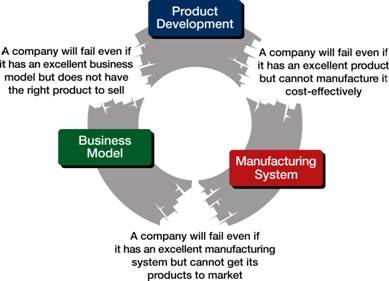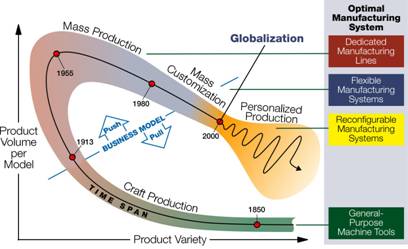Global Manufacturing – Teaching Objectives
Realizing the increasingly complex global economy and the need to develop leaders for the 21st Century manufacturing enterprises, Professor Koren started, in 1995, to offer a Global Manufacturing class (ME-587, MFG-587, OMS-587). In this class graduate students from engineering and business schools learn the insights of strategic thinking needed to guide global manufacturing enterprises in the current turbulent business environment. In 2010 Koren published the course notes in a textbook: The Global Manufacturing Revolution: Product-Process-Business Integration and Reconfigurable Manufacturing.
The two basic fundamentals of strategic thinking for manufacturing enterprises, according to Koren’s thoughts, are
1. Utilize systems viewpoint, and
2. Analyzing past and present paradigms enables predicting future trends.
1. The Systems Perspective
Manufacturing enterprises are involved in three activities: Design, Make, Sell.
The sequence of these three activities, and their relationships are critical for enterprise success.
The literature describes three manufacturing paradigms: Craft Production, Mass Production, and Mass Customization. Koren’s analysis shows that each paradigm has its unique sequence:
Paradigm Sequence
- Craft Production: Sell—> Design—> Make
- Mass Production: Design—> Make—> 0E7304
- Mass Customization: Design—> Sell—>Make
The relationships among the three activities are critical for success, as the example in the following diagram shows. (The drawing is taken from The Global Manufacturing Revolution, all rights reserved.)

2. Analyzing along Times— Studying past paradigms may predict future paradigms
Throughout modern history, new manufacturing paradigms have been driven by changes in markets and customer needs. The graph below (taken from The Global Manufacturing Revolution, all rights reserved) shows how change has propelled these transitions. Globalization impels regional customization and personalized production, as society seeks more variety. Market fluctuations, which grow every day, force manufacturers to produce even smaller volumes per each product variant. The Personalized Production paradigm is approaching.

It is necessary for leaders of manufacturing enterprises to be strategic thinkers, visionary, and possess determination and skills to achieve that vision. These leaders should know principles of design and operations of manufacturing systems, comprehend product invention strategies, possess knowledge in business models, and be able to predict market inclinations for new products based on manufacturing history and globalization trends. The Global Manufacturing class seamlessly blends all these subjects into a coherent course. The course aims at developing leaders who are strategic thinkers and capable of processing information both quantitatively and qualitatively.
To help students to apply the tools necessary to deal with the challenges that exist in a manufacturing environment, this class contains a team project in which students design a new product, design the factory and supply chain to produce it, and plan a business model to sell the product. Students learn thereby to be team players, prepare reports and presentations, and most importantly be effective communicators. ME-587 graduates will become effective leaders who think strategically and make a difference in complex, global manufacturing enterprises.
“Our new vision for GM is simple: Design, Build, and Sell the world’s best vehicles.”
– Mark Reuss, President, GM North America. Detroit, Michigan, January 12, 2010
